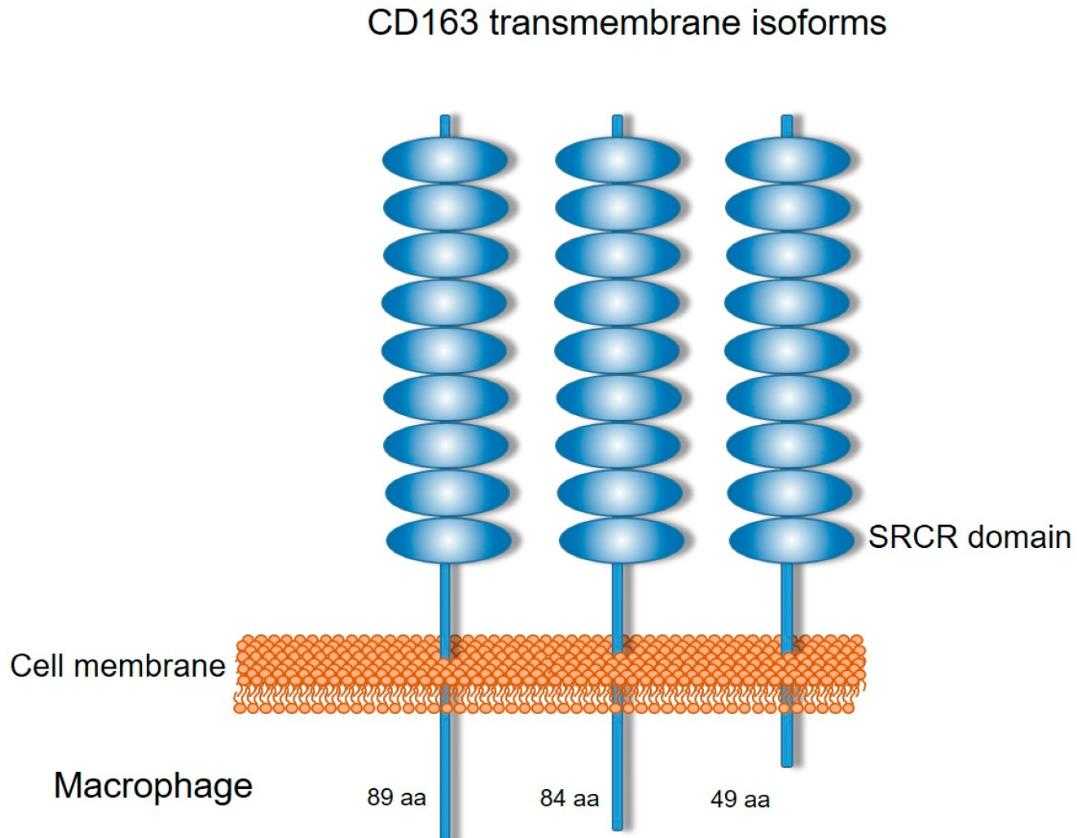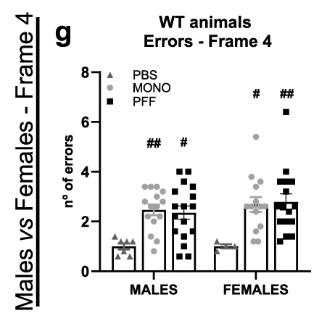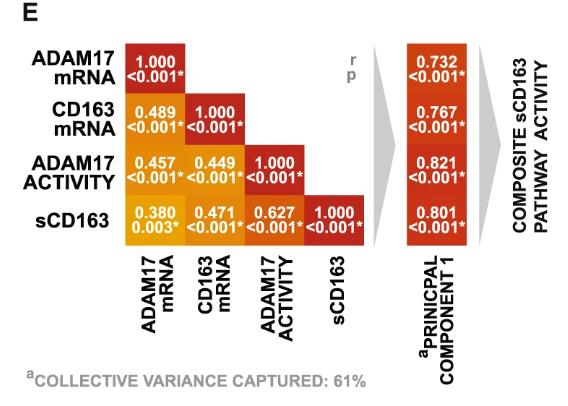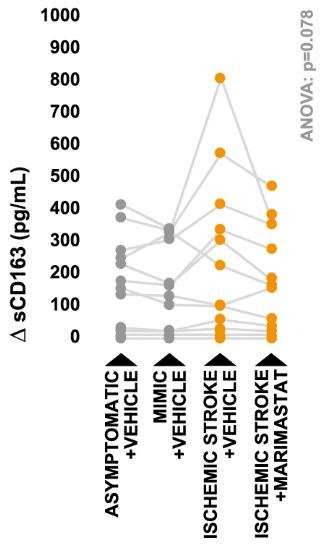CD163
-
Official Full Name
CD163 Molecule -
Overview
CD163 (Cluster of Differentiation 163) is a human protein encoded by the CD163 gene. Acute phase-regulated receptor involved in clearance and endocytosis of hemoglobin/haptoglobin complexes by macrophages and may thereby protect tissues from free hemoglobin-mediated oxidative damage. May play a role in the uptake and recycling of iron, via endocytosis of hemoglobin/haptoglobin and subsequent breakdown of heme. Binds hemoglobin/haptoglobin complexes in a calcium-dependent and pH-dependent manner. Exhibits a higher affinity for complexes of hemoglobin and multimeric haptoglobin of HP*1F phenotype than for complexes of hemoglobin and dimeric haptoglobin of HP*1S phenotype. Induces a cascade of intracellular signals that involves tyrosine kinase-dependent calcium mobilization, inositol triphosphate production and secretion of IL6 and CSF1. Isoform 3 exhibits the higher capacity for ligand endocytosis and the more pronounced surface expression when expressed in cells. After shedding, the soluble form (sCD163) may play an anti-inflammatory role, and may be a valuable diagnostic parameter for monitoring macrophage activation in inflammatory conditions. -
Synonyms
M130;MM130;scavenger receptor cysteine-rich type 1 protein M130;OTTHUMP00000238617;OTTHUMP00000238618;CD163 Molecule;OTTHUMP00000238619;OTTHUMP00000238620;hemoglobin scavenger receptor;macrophage-associated antigen;CD163
Recombinant Proteins
- Human
- Mouse
- Rat
- Pig
- E.coli
- Mammalian cells
- C-His
- Wheat Germ
- HEK293
- Baculovirus-Insect cells
- Human cells
- Yeast
- GST
- His
- His&T7
- Non
- His&Avi
- Myc&DDK
- His&Fc&Avi
- Flag
- His&Myc
Background

Fig1. Schematic representation of the three CD163 transmembrane isoforms. (Andriana Plevriti, 2024)
What is CD163 Protein?
CD163 gene (CD163 molecule) is a protein coding gene which situated on the short arm of chromosome 12 at locus 12p13. This gene cranks out a protein that's part of the scavenger receptor family, mainly found in monocytes and macrophages. Its big job? Helping clean up by grabbing and digesting hemoglobin/haptoglobin stuff to shield tissues from oxidative damage caused by free hemoglobin. Besides that, it might also act as an immune lookout, sensing bacteria and kick-starting local inflammation. The CD163 protein is consisted of 1156 amino acids and CD163 molecular weight is approximately 125.5 kDa.
What is the Function of CD163 Protein?
CD163 not only helps remove metabolic waste, it also acts as a sensor for the immune system. It recognizes and responds to the signals of certain bacterial infections, initiates local inflammatory responses, and protects the body from oxidative damage caused by free hemoglobin. We also see it present more in body fluids in some inflammatory diseases, such as cirrhosis, diabetes and sepsis, where its levels are elevated. In addition, CD163 is also expressed in the central nervous system, especially after bleeding, and its role in neurons is still being studied. It can be said that the CD163 protein is not only responsible for cleaning up and recycling bad molecules inside the body, but also participates in our immune defense and inflammatory response to a certain extent.
CD163 Related Signaling Pathway
In general, CD163 recognizes bacteria in the immune system and helps rid the body of pathogens. CD163 plays an important role in the inflammatory response, especially when dealing with hemoglobin that is formed after bleeding. This receptor protects tissue from oxidative damage that can result from free hemoglobin. In addition, the soluble form of CD163 is also increased in the blood in some diseases such as cirrhosis, diabetes, and certain infectious states. Understanding this protein and its role can lead to more in-depth research and treatment of related diseases.
CD163 Related Diseases
CD163 recognizes and binds to hemoglobin-haptoglobin complexes to help clear these complexes and prevent oxidative damage caused by hemoglobin. In addition, it acts as a sensor of innate immunity, detects bacteria and is active in the inflammatory response. Most interestingly, CD163 is increased in inflammatory diseases such as liver cirrhosis, type 2 diabetes, sepsis, and HIV infection. When these conditions occur in the body, we can detect a form called "soluble CD163" in the blood, which is produced by the shear of membrane binding CD163. Studies have found that this soluble form is associated with changes in the condition of a variety of diseases and can even be used to monitor response to treatment.
Bioapplications of CD163
This protein, found primarily in monocytes and macrophages, is responsible for cleaning out the hemoglobin-haptoglobin complex in the blood, which is important for protecting body tissues from oxidative damage caused by free hemoglobin. In addition, it acts as a congenital immune sensor that can sense bacteria and trigger local inflammatory responses. For some inflammation-related diseases, such as cirrhosis, rheumatoid arthritis, and sepsis, levels of lytic CD163 (sCD163) are significantly elevated, making it a potential disease biomarker. In pathological studies, CD163 is also used as a tool to label macrophages, helping researchers understand how these immune cells behave and function in a variety of health and disease states.
Case Study
Case Study 1: Sara A. Ferreira, 2023
In Parkinson's disease (PD), a couple of key events are the buildup of alpha-synuclein (α-syn) and the activation of the immune system. This immune response involves both brain and peripheral immune cells, but we don't know a lot about which immune proteins play major roles. Researchers think that the increase in CD163 levels seen in blood monocytes and active microglia of PD patients might act as a defense mechanism. To dig deeper into this, researchers used a PD model with mice that had CD163 knocked out (KO) and compared them to their normal littermates. In female CD163KO mice, there was a noticeable early difference in the immune response to α-syn, observed through various analyses. After six months, these CD163KO females had a ramped-up immune reaction and worsening α-syn pathology, leading to more severe dopamine neuron damage.

Fig1. Show error differences between males and females in WT animals.

Fig2. Bar graph showing the number of up/downregulated genes in CD163KO vs. WT females.
Case Study 2: Grant C. O'Connell, 2017
This study looked at how CD163 is involved in suppressing the immune system after a stroke. Researchers checked blood samples from 39 stroke patients, 20 people without neurological issues, and 20 with stroke-like symptoms within 24 hours of when symptoms appeared. They found that people who'd had a stroke had higher levels of ADAM17 activity and soluble CD163 in their blood, which was linked to lower lymphocyte counts after the stroke. Further lab tests suggested that the rise in soluble CD163 might come from activated monocytes because stroke patients' serum caused healthy donor monocytes to release CD163 with the help of ADAM17. More tests showed that this increased soluble CD163 could actually suppress the immune system, as stroke patients' serum halted the growth of lymphocytes from healthy donors, but this effect lessened when CD163 was removed from the serum.

Fig3. Correlation matrix depicting the group-wide collective relationships between peripheral blood ADAM17 mRNA expression, CD163 mRNA expression, ADAM17 activity, and sCD163 levels.

Fig4. Neutrophil-derived sCD163 levels in cell culture supernatants collected following treatment.
Quality Guarantee
High Purity
.jpg)
Fig1. SDS-PAGE (CD163-0726H)
.
.jpg)
Fig2. SDS-PAGE (CD163-064H)
Involved Pathway
CD163 involved in several pathways and played different roles in them. We selected most pathways CD163 participated on our site, such as Binding and Uptake of Ligands by Scavenger Receptors,Scavenging of heme from plasma,Vesicle-mediated transport, which may be useful for your reference. Also, other proteins which involved in the same pathway with CD163 were listed below. Creative BioMart supplied nearly all the proteins listed, you can search them on our site.
| Pathway Name | Pathway Related Protein |
|---|---|
| Vesicle-mediated transport | DTNBP1B,COPB2,SNX9B,TRAPPC6BL,FTH1A,BLOC1S6,COPG,GAK,HP,HIP1RB |
| Binding and Uptake of Ligands by Scavenger Receptors | NFX1,LOC479668,HSPH1,AMBP,Alb,APOBB.1,SAA1,IGKV1-5,IGKC,APOA1B |
| Scavenging of heme from plasma | HP,HPX,AMBP,LOC479668,NFX1 |
Protein Function
CD163 has several biochemical functions, for example, protein binding,scavenger receptor activity. Some of the functions are cooperated with other proteins, some of the functions could acted by CD163 itself. We selected most functions CD163 had, and list some proteins which have the same functions with CD163. You can find most of the proteins on our site.
| Function | Related Protein |
|---|---|
| protein binding | HELZ2,FAM212A,MAL,THG1L,DNAI1,RARA,PRMT6,TRIM5,CNOT1,ZHX1 |
| scavenger receptor activity | CD6,CD5L,TMPRSS4A,SCARA5,TMPRSS3,SRCRB4D,C8orf84,LOXL2B,LGALS3BPB,CXCR7 |
Interacting Protein
CD163 has direct interactions with proteins and molecules. Those interactions were detected by several methods such as yeast two hybrid, co-IP, pull-down and so on. We selected proteins and molecules interacted with CD163 here. Most of them are supplied by our site. Hope this information will be useful for your research of CD163.
uup
Resources
Research Area
Myeloid Lineage MarkersMyeloid Cell
Other Dendritic Cell CD Antigen
Macrophage Marker CD Antigen
Macrophage Markers
Monocyte Markers
Scavenger Receptors
Related Services
Related Products
References
- Ong, CB; Brandenberger, C; et al. Immunohistochemical Characterization and Morphometric Analysis of Macrophages in Rat Mammary Tumors. VETERINARY PATHOLOGY 52:414-418(2015).
- Theate, I; van Baren, N; et al. Extensive Profiling of the Expression of the Indoleamine 2,3-Dioxygenase 1 Protein in Normal and Tumoral Human Tissues. CANCER IMMUNOLOGY RESEARCH 3:161-172(2015).


